In literal terms, Zen refers to meditation. In interior design, it refers to creating an ambience that is tranquil, peaceful and meditative. The hubbub of urban life takes a toll on the mental well-being of any individual. This coupled with pollution and chaos can leave us pretty irritable and exhausted. What better solution, then, than transforming your home into a Zen sanctuary away from it all?
![2016-01-08-1452228766-493525-01.jpg]()
Zen décor combines a Japanese aesthetic and minimalism, with an emphasis on using ample indoor landscaping. It is associated with simplicity and straight lines. Here are a few tips to get you started
Reduce the colour palette of your home to soothing neutrals with a pop of green. Use beige, sand, eggshell colours along with light wood and wicker furniture. These colours instil a sense of peace and calm into the decor and into your psyche.
You can play with an array of natural materials and textures such as jute, bamboo and stone in the decor to make up for the absence of colour. But try and keep it as simple as possible.
![2016-01-08-1452228811-6832993-02.jpg]()
As the thumb-rule for minimalism states, declutter first! Get rid of unwanted things that obstruct the flow of fresh Chi, or positive energy. Go for furniture with built-in seamless storage in a light-wood finish. Steer clear of too many details. Do away with knobs and handles on drawers but give niches and punctures wherever necessary. Use natural wood furniture with veneer finish. Avoid laminates.
![2016-01-08-1452228852-4445200-03.jpg]()
Even if you do not use wood, ensure that the colours do not deviate from the decor scheme. Use low-heighted furniture which will add to the minimalist and open ambience.
Again, use natural wood, stone and marble in neutral colours.
![2016-01-08-1452228897-7053010-04.jpg]()
Since you will be using a very subtle and muted colour scheme, you can add some visual interest by varying the colour of wooden flooring versus the furniture like we see in the image. Since both are composed of natural materials, the decor will be cohesive and in harmony.
![2016-01-08-1452229019-7605308-05.jpg]()
If you are using a carpet, ensure it is in a natural material like cotton; avoid shaggy and woollen rugs.
Use a lot of cotton and linen upholstery in solid but neutral colours. For visual interest, you could go for cushions in various shapes and sizes and stack them together.
![2016-01-08-1452229053-5271439-06.jpg]()
If you really want to use prints, stick to a scheme. Either use natural flora and fauna motifs or stick to geometric patterns only. Heavy draperies should be avoided. Go for pretty and elegant bamboo chattai mats on the windows. You can also go for simple sheer-blinds coupled with a complete or semi-blackout blinds.
While traditionally, Japanese decor calls for bamboo plants in the house, you can use any and every indoor plant to adorn your space. Create terrarium gardens and hang them on the windows.
![2016-01-08-1452229093-7819832-07.jpg]()
![2016-01-08-1452229124-5451643-09.jpg]()
Water is essential to Zen decor. Synonymous with energy and life, keep a water feature (with moving water) in the living room.
![2016-01-08-1452230296-8268250-08.jpg]()
A fish tank would be an amazing addition. If you cannot go for a full-fledged tank, you can get a simple fish bowl with a pair of gold-fish or neon fish in it. It will have the same impact, minus the fuss of maintenance.
7. Art and accessories
Yes, every home is incomplete without a little personal touch. Use simple candles in various corners of your house.
![2016-01-08-1452229726-8721475-10.jpg]()
Fill a simple glass with water and pebbles and add a tea-light candle for a lovely Zen ambience! If you are hanging paintings on the wall, go for natural landscapes and traditional Japanese art instead of vivid ones.
![]() Like Us On Facebook |
Like Us On Facebook |
![]() Follow Us On Twitter |
Follow Us On Twitter |
![]() Contact HuffPost India
Contact HuffPost India
Also see on HuffPost:
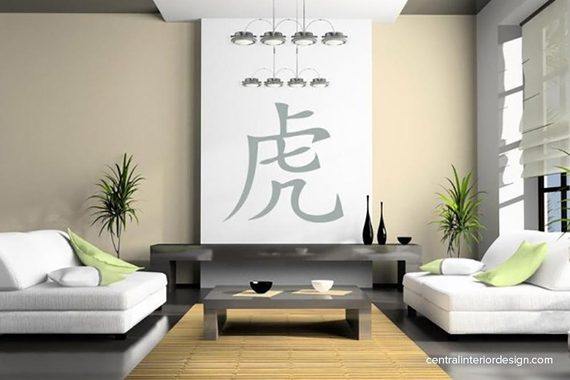
Zen décor combines a Japanese aesthetic and minimalism, with an emphasis on using ample indoor landscaping. It is associated with simplicity and straight lines. Here are a few tips to get you started
1. A muted colour palette
Reduce the colour palette of your home to soothing neutrals with a pop of green. Use beige, sand, eggshell colours along with light wood and wicker furniture. These colours instil a sense of peace and calm into the decor and into your psyche.
You can play with an array of natural materials and textures such as jute, bamboo and stone in the decor to make up for the absence of colour. But try and keep it as simple as possible.
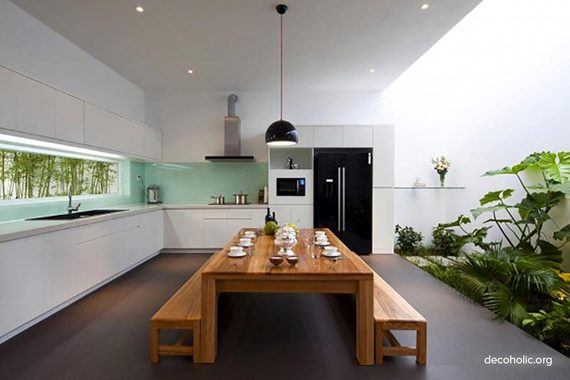
2. Furniture: Less is more
As the thumb-rule for minimalism states, declutter first! Get rid of unwanted things that obstruct the flow of fresh Chi, or positive energy. Go for furniture with built-in seamless storage in a light-wood finish. Steer clear of too many details. Do away with knobs and handles on drawers but give niches and punctures wherever necessary. Use natural wood furniture with veneer finish. Avoid laminates.
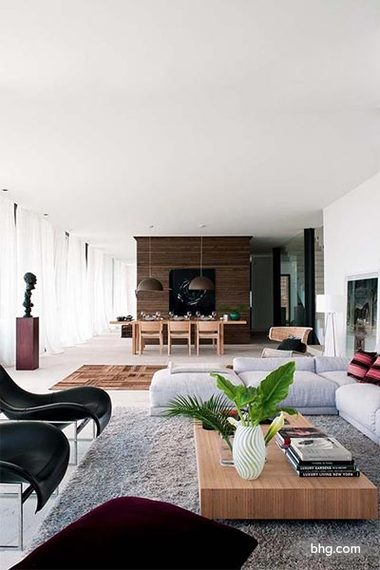
Even if you do not use wood, ensure that the colours do not deviate from the decor scheme. Use low-heighted furniture which will add to the minimalist and open ambience.
3. Harmonious flooring
Again, use natural wood, stone and marble in neutral colours.
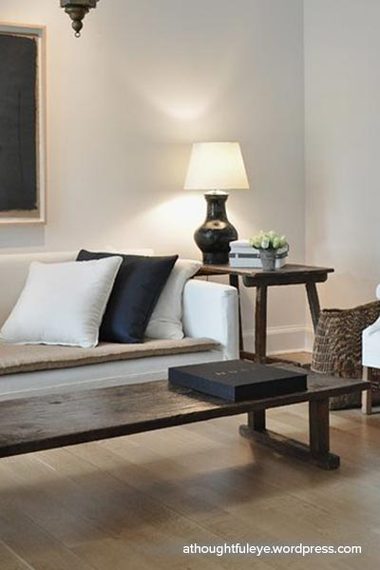
Since you will be using a very subtle and muted colour scheme, you can add some visual interest by varying the colour of wooden flooring versus the furniture like we see in the image. Since both are composed of natural materials, the decor will be cohesive and in harmony.
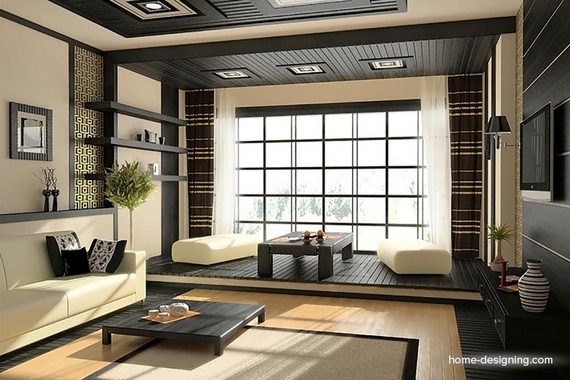
If you are using a carpet, ensure it is in a natural material like cotton; avoid shaggy and woollen rugs.
4. Easy-breathing fabrics
Use a lot of cotton and linen upholstery in solid but neutral colours. For visual interest, you could go for cushions in various shapes and sizes and stack them together.
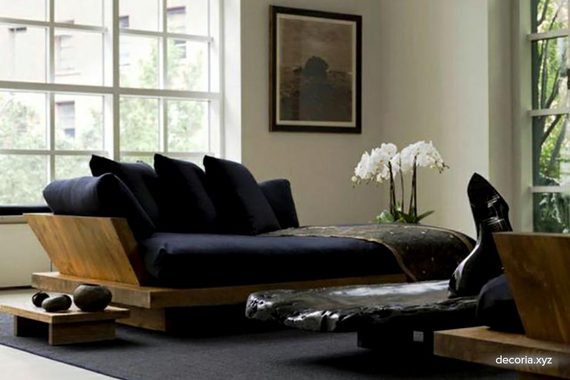
If you really want to use prints, stick to a scheme. Either use natural flora and fauna motifs or stick to geometric patterns only. Heavy draperies should be avoided. Go for pretty and elegant bamboo chattai mats on the windows. You can also go for simple sheer-blinds coupled with a complete or semi-blackout blinds.
5. Use plants
While traditionally, Japanese decor calls for bamboo plants in the house, you can use any and every indoor plant to adorn your space. Create terrarium gardens and hang them on the windows.
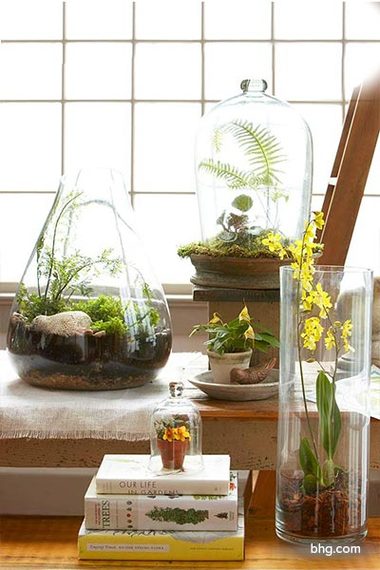
6. Add an element of water
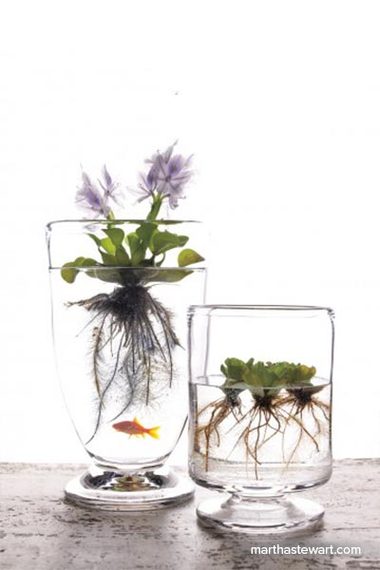
Water is essential to Zen decor. Synonymous with energy and life, keep a water feature (with moving water) in the living room.

A fish tank would be an amazing addition. If you cannot go for a full-fledged tank, you can get a simple fish bowl with a pair of gold-fish or neon fish in it. It will have the same impact, minus the fuss of maintenance.
7. Art and accessories
Yes, every home is incomplete without a little personal touch. Use simple candles in various corners of your house.
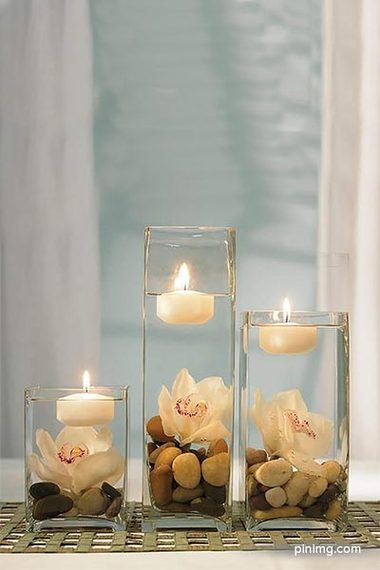
Fill a simple glass with water and pebbles and add a tea-light candle for a lovely Zen ambience! If you are hanging paintings on the wall, go for natural landscapes and traditional Japanese art instead of vivid ones.
 Like Us On Facebook |
Like Us On Facebook |  Follow Us On Twitter |
Follow Us On Twitter | Also see on HuffPost: